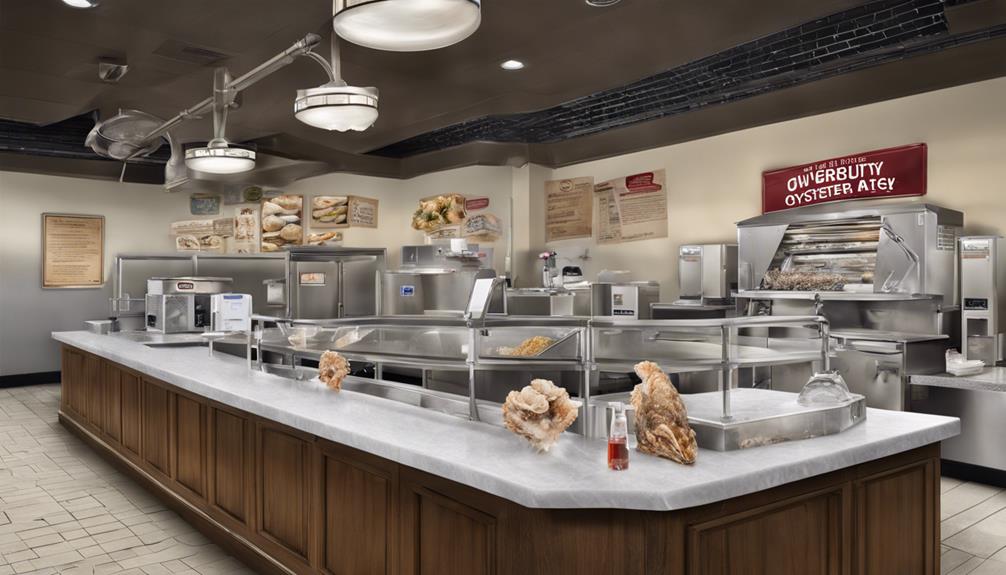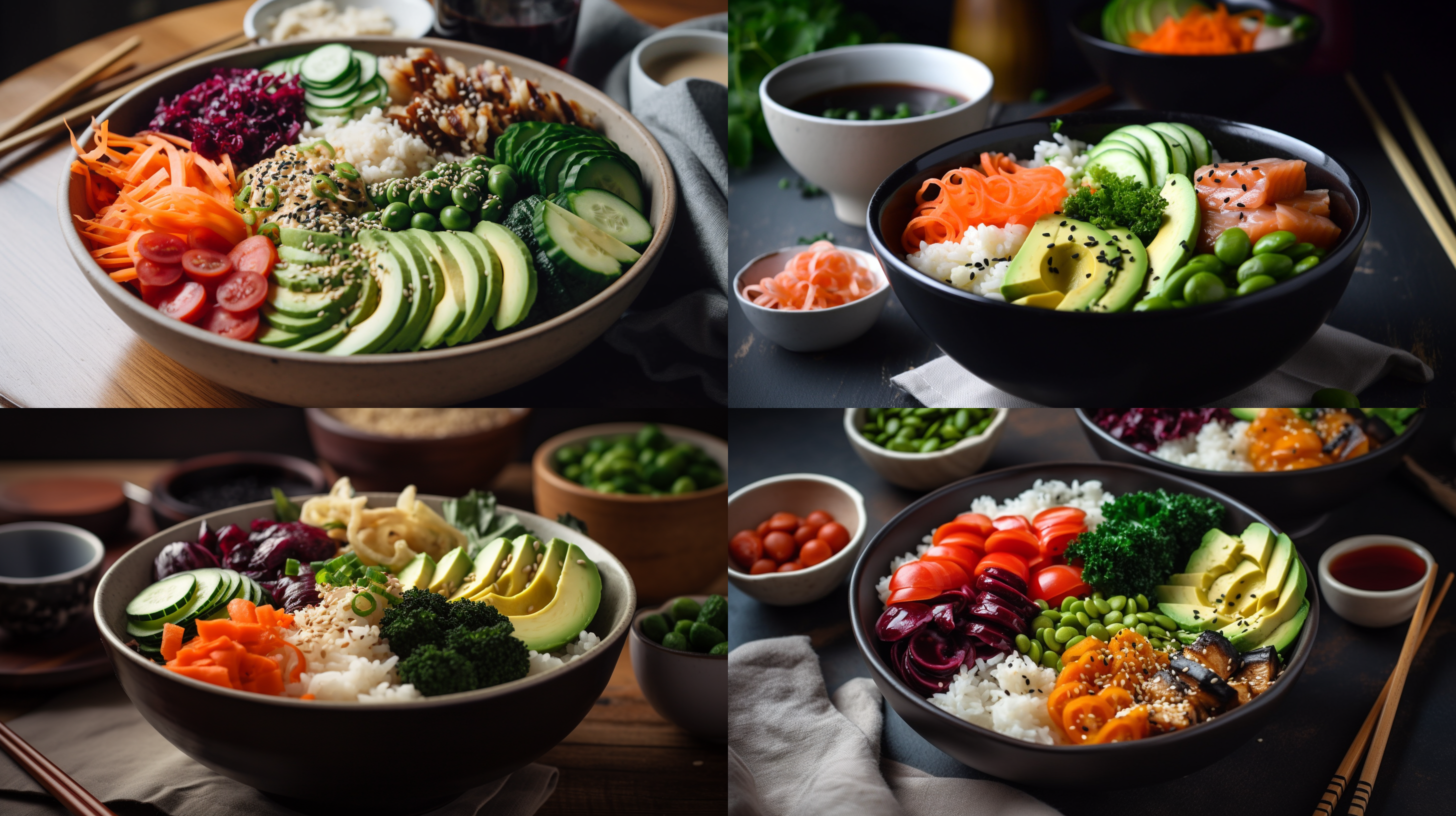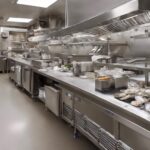In order to guarantee the safe operation of a raw oyster establishment, it is crucial to meet certain key requirements. This includes regulatory compliance measures that focus on food safety and educating customers on shellfish safety. Licensed oyster dealers must follow NSSP standards, implement HACCP and GMPs, and perform hazard analysis procedures to identify critical control points and ensure safety. Proper oyster handling practices, staff training, and measures for preventing pathogens are essential in maintaining the safety of oyster handling, storage, and serving. By prioritizing these requirements, an oyster establishment can effectively protect consumer well-being and satisfaction.
Key Takeaways
- Prominently display consumer advisory statements.
- Strict adherence to NSSP Standards.
- Robust food safety and sanitation plan implementation.
- Thorough staff training on oyster safety and handling.
- Maintain proper oyster storage and handling practices.
Regulatory Compliance Measures
To comply with regulations, raw oyster establishments must prominently display a consumer advisory statement. This statement serves as an important reminder of the potential risks associated with consuming raw oysters, emphasizing the significance of proper food safety measures. Making sure that this advisory is visible to all patrons helps to educate them about shellfish safety and encourages informed decision-making.
In addition to the consumer advisory, implementing a thorough food safety plan is essential for maintaining a safe environment in raw oyster establishments. This plan should outline protocols for temperature control, sanitation practices, and risk management strategies. By following these guidelines, establishments can minimize the potential for foodborne illnesses and ensure the well-being of their customers.
Licensed Oyster Dealers

Licensed oyster dealers strictly follow the National Shellfish Sanitation Program (NSSP) standards to guarantee safe handling and distribution of oysters. When it comes to ensuring the safety of oysters and maintaining regulatory compliance, being a licensed oyster dealer involves a set of essential requirements:
- Adhering to NSSP Standards: Compliance with the NSSP guidelines is vital to uphold the highest standards of oyster safety.
- Implementing HACCP and GMPs: Following Hazard Analysis and Critical Control Points (HACCP) and Good Manufacturing Practices (GMPs) makes certain that oysters are handled and processed in a safe manner.
- Training and Licensing Oyster Harvesters: Licensed oyster dealers must ensure that their harvesters are trained and licensed to meet regulatory requirements.
- Renewal and Verification: Regular renewal of certifications is essential to demonstrate ongoing commitment to safe oyster handling practices. Being listed on the Interstate Shellfish Shippers List, managed by the FDA, verifies compliance with NSSP guidelines for licensed oyster dealers.
Hazard Analysis Procedures
When considering hazard analysis procedures for a raw oyster establishment, two key points come to mind:
- The utilization of risk assessment tools
- The implementation of a safety training program
These aspects are pivotal in identifying and addressing potential hazards in oyster production and handling. By integrating these practices, we can enhance the safety and quality of raw oysters for consumers.
Risk Assessment Tools
Implementing Hazard Analysis Critical Control Points (HACCP) procedures is crucial for guaranteeing the safety of raw oyster products in establishments. When it comes to risk assessment tools, here are four key points to ponder:
- Hazard Analysis: Conduct a thorough analysis to identify potential hazards in the food production process.
- Critical Control Points: Determine the critical points where control measures are necessary to prevent or eliminate hazards.
- Monitoring Procedures: Establish monitoring procedures to make sure that control measures are being implemented effectively.
- Risk Reduction: Utilize HACCP principles to prevent, eliminate, or reduce risks in the production of raw oyster products, thereby safeguarding consumers' health and well-being.
Safety Training Program
Developing a thorough safety training program incorporating Hazard Analysis Procedures is essential for ensuring the protection of consumers and the integrity of raw oyster establishments. This program should encompass important aspects such as HACCP procedures, proper handling techniques, prevention of foodborne illnesses, and adherence to safety protocols.
Employees need to be well-versed in monitoring and controlling critical points in the oyster handling process to maintain a safe environment. Regular training sessions are crucial to keep all staff members updated on the latest safety regulations and best practices.
Good Manufacturing Practices (GMPs)

Maintaining strict adherence to Good Manufacturing Practices (GMPs) guarantees the safe and hygienic production of raw oysters.
- GMPs are essential for ensuring food safety by outlining minimum requirements for cleanliness and hygiene in production facilities.
- These practices cover aspects such as equipment maintenance to prevent contamination and employee hygiene to uphold cleanliness standards.
- Compliance with GMPs is vital to meet regulatory requirements, ensuring that raw oyster establishments operate in accordance with food safety standards.
- By following GMP guidelines, establishments establish standard operating procedures that help maintain quality and consistency in the processing of raw oysters, protecting public health.
Adhering to GMPs not only safeguards the health of consumers but also fosters trust in the quality of raw oysters produced. It's crucial for raw oyster establishments to prioritize GMP compliance to uphold the highest standards of hygiene and safety in their operations.
Licensed and Trained Harvesters

To guarantee compliance with safety regulations, harvesters must obtain licensing under the National Shellfish Sanitation Program (NSSP). This ensures that they are trained in proper handling techniques and understand the importance of maintaining shellfish safety standards. Training programs play an essential role in educating harvesters on how to prevent contamination and recognize signs of spoilage in shellfish batches. By renewing their certifications annually, licensed harvesters stay updated on the latest safety protocols, enhancing their ability to uphold regulatory standards. Compliance with licensing and training requirements is critical for a raw oyster establishment to prioritize consumer safety and maintain the integrity of their products.
| Licensed Harvesters | Training Programs | Compliance with Safety Regulations |
|---|---|---|
| Ensure proper handling techniques | Educate on contamination prevention | Uphold safety standards |
| Renew certifications annually | Recognize signs of spoilage | Prioritize consumer safety |
| Stay updated on safety protocols | Prevent contamination | Maintain regulatory standards |
Proper Oyster Handling

Proper oyster handling is essential for maintaining food safety standards in a raw oyster establishment.
Hygiene practices, storage guidelines, and staff training play key roles in ensuring oysters are safe for consumption.
Hygiene Practices
To ensure peak hygiene practices in a raw oyster establishment, rigorous handwashing protocols must be strictly adhered to by all staff before and after handling oysters. Proper hand washing is vital in preventing cross-contamination and reducing the risk of foodborne illnesses.
Here are essential hygiene practices to maintain a safe oyster environment:
- Follow Handwashing Protocols: Wash hands thoroughly before and after handling oysters.
- Use Separate Equipment: Utilize separate cutting boards and utensils for raw oysters to prevent cross-contamination.
- Sanitize Equipment: Regularly clean and sanitize oyster shucking equipment to uphold hygiene standards.
- Educate Staff: Provide training on proper oyster handling techniques to minimize the risk of foodborne illnesses.
Storage Guidelines
Storing live shellfish correctly is crucial for maintaining their freshness and safety. To uphold food safety standards, store shellfish in the refrigerator on ice, avoiding airtight containers to prevent suffocation.
Remember to keep shellfish refrigerated and serve on ice within 30 minutes of shucking for peak quality. Prevent cross-contamination by storing shellfish away from raw meat during storage.
Additionally, make sure chefs are trained in proper shucking techniques to maintain food safety standards. By following these storage guidelines diligently, you not only preserve the freshness and flavor of the oysters but also prioritize the health and well-being of those who'll enjoy them.
Staff Training
Upon receiving comprehensive training on oyster handling techniques, staff members can effectively prevent contamination and maintain food safety standards. Essential staff training is vital in ensuring the quality and safety of raw oysters served to customers.
Here are key aspects of staff training for oyster handling:
- Educating staff on shucking procedures to minimize the risk of cross-contamination.
- Providing guidelines on proper storage practices to preserve oyster freshness.
- Emphasizing temperature control measures to prevent bacterial growth.
- Training staff to recognize signs of spoilage or contamination in oysters, promoting swift action to safeguard consumer health and uphold food safety regulations.
Safe Oyster Storage

For essential freshness and safety, live oysters in a raw oyster establishment should be stored refrigerated on ice. Proper oyster storage is vital to maintain their quality and reduce the risk of contamination. Storing oysters in a refrigerator helps prevent bacterial growth, ensuring food safety for consumers. Avoid placing live oysters in airtight containers as this can lead to suffocation and spoilage. By following these storage practices, the shelf life of oysters can be extended, allowing them to retain their freshness.
| Storage Method | Benefits | Risks |
|---|---|---|
| Refrigeration | Prevents bacterial growth | None |
| Ice | Maintains freshness | None |
| Airtight containers | Risk of suffocation | Spoilage |
| Proper handling | Reduced contamination risk | None |
Maintaining the quality of live oysters through safe storage practices is essential for any raw oyster establishment. By refrigerating them on ice and avoiding airtight containers, the oysters can stay fresh, safe, and enjoyable for customers to consume.
Pathogen Prevention Measures

Strict temperature control measures are crucial for preventing pathogen growth in raw oysters. To guarantee the safety of our oysters, I prioritize the following pathogen prevention measures:
- Monitor Refrigeration: Regularly check and maintain refrigeration units at or below 41°F (5°C) to inhibit bacterial proliferation effectively.
- Invest in Quality Units: Utilize high-quality and reliable refrigeration equipment to keep oysters fresh and safe for consumption, safeguarding against pathogen contamination.
- Educate Staff: Train all team members on proper handling procedures to minimize contamination risks, emphasizing the importance of maintaining food safety standards.
- Adhere to FDA Guidelines: Follow the Food and Drug Administration (FDA) guidelines for pathogen prevention in raw oyster establishments meticulously. These guidelines are designed to protect consumer health and well-being, ensuring that our oysters meet the highest safety standards.
Consumer Safety Priority

Guaranteeing consumer safety is our top priority at this raw oyster establishment. We exhibit consumer advisory statements to caution about the risks of consuming raw shellfish, ensuring transparency and empowering informed choices.
Allergen information for items containing raw shellfish is clearly labeled, catering to individual dietary needs and promoting a safe dining experience. Our robust food safety and sanitation plan effectively manages risks associated with shellfish handling, ensuring the highest standards of hygiene and care.
By maintaining temperature logs, shellfish tags, and illness/complaint logs for at least ninety days, we uphold accountability and traceability in our operations, fostering trust with our patrons. Cultivating a strong food safety culture among our staff is paramount, as it ensures consistent implementation of safe food handling practices, safeguarding the well-being of our valued customers.
Your safety and satisfaction are at the core of everything we do.
Dining Experience Assurance

To guarantee a high-quality dining experience, it's vital to uphold strict cleanliness standards in a raw oyster establishment. Staff members must be thoroughly trained on proper shucking techniques and the safe handling of raw shellfish to secure customer safety and satisfaction.
Cleanliness Standards Upheld
Maintaining high cleanliness standards in the dining area is essential for ensuring a positive and safe dining experience for customers. When it comes to cleanliness standards being upheld in a raw oyster establishment, here are some key points to ponder:
- Regular cleaning schedules help maintain high cleanliness standards.
- Proper sanitation practices are vital for promoting food safety.
- Following cleaning protocols diligently reduces the risk of contamination.
- Adherence to cleanliness standards isn't only necessary for regulatory compliance but also plays a significant role in ensuring customer satisfaction.
Staff Knowledge Training
Shifting our focus from cleanliness standards in the dining area, we now turn our attention to the crucial aspect of staff knowledge training in a raw oyster establishment for guaranteeing an exceptional dining experience. Staff training plays a central role in upholding food safety, mastering oyster varieties, understanding proper handling techniques, and ensuring customer satisfaction. Here is a breakdown of the essential components of staff knowledge training in a raw oyster establishment:
| Training Aspect | Description | Importance |
|---|---|---|
| Oyster Varieties & Handling | Educating staff on different oyster types, flavor profiles, shucking techniques, and presentation | Secures quality experience |
| Food Safety & Storage Procedures | Training on allergen information, proper storage, and oyster safety to prevent contamination | Maintains food safety |
| Local Sourcing & Sustainability | Understanding local sources, seasonal availability, and sustainability practices | Enhances customer interactions |
| Menu Descriptions & Pairing Tips | Continuous education on menu descriptions, pairing suggestions, and customer engagement strategies | Elevates overall dining experience |
Frequently Asked Questions
What Should an Establishment That Serves Raw Oysters Have?
When serving raw oysters, I must guarantee proper handling, labeling, and sanitation practices are in place. This includes maintaining temperature logs, allergen information, and training in shucking techniques to uphold food safety standards and regulatory compliance.
What Do You Need for Raw Oysters?
For raw oysters, you need proper refrigeration, handwashing facilities, consumer warnings, bacteria testing, and staff training. These essentials guarantee oyster safety and prevent foodborne illnesses. I prioritize these requirements to uphold quality standards in our establishment.
What Makes a Good Raw Oyster?
Savoring succulent, fresh raw oysters excites my senses. Clean taste, plump texture, sweet sea scent, and tight shells signify quality. Ice-cold presentation enhances their flavor. It's a delightful experience that never disappoints.
What Do Oysters Need?
Oysters need proper storage and handling to guarantee freshness and safety. They require refrigeration on ice, meticulous shucking techniques, and clear information for customers. Keeping shellfish away from raw meat is vital to prevent cross-contamination.
Are the Requirements for Handling Raw Fish Fillets Similar to Handling Raw Oysters?
When it comes to hazardfree raw fish fillets preparation, safety protocols resemble those for oysters. Both demand meticulous cleaning, cold storage, and proper handling to prevent cross-contamination. Ensuring fresh, quality seafood and adherence to sanitary guidelines are universal steps for risk-free consumption.
Conclusion
In summary, ensuring that a raw oyster establishment meets essential requirements is vital for the safety and satisfaction of customers.
By following regulatory compliance measures, implementing hazard analysis procedures, and prioritizing consumer safety, the establishment can guarantee a positive dining experience.
Remember, when it comes to raw oysters, it's better to be safe than sorry.

















